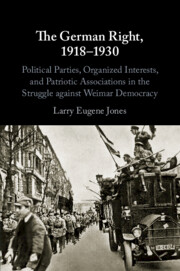 The German Right, 1918–1930
The German Right, 1918–1930 Published online by Cambridge University Press: 21 March 2020
Chapter 1 offers a brief overview of right-parties in the late Second Empire, including the German Fatherland Party, before moving to a more thorough analysis of the way in which the German Right reacted to Germany’s defeat in World War I and the revolutionary upheaval it left in its wake. It focuses in particular to unify the various factions of the German Right that had existed before World War I into a new political party, the German National People’s Party (DNVP), in preparation for the elections to the Weimar National Assembly and the Prussian Constitutional Assembly in January 1919. It also examines the reluctance with which the leaders of the German Conservative Party – in particular its parliamentary leader Count Kuno von Westarp – embraced the new party and the problem this posed for the DNVP’s future political development.
To save this book to your Kindle, first ensure [email protected] is added to your Approved Personal Document E-mail List under your Personal Document Settings on the Manage Your Content and Devices page of your Amazon account. Then enter the ‘name’ part of your Kindle email address below. Find out more about saving to your Kindle.
Note you can select to save to either the @free.kindle.com or @kindle.com variations. ‘@free.kindle.com’ emails are free but can only be saved to your device when it is connected to wi-fi. ‘@kindle.com’ emails can be delivered even when you are not connected to wi-fi, but note that service fees apply.
Find out more about the Kindle Personal Document Service.
To save content items to your account, please confirm that you agree to abide by our usage policies. If this is the first time you use this feature, you will be asked to authorise Cambridge Core to connect with your account. Find out more about saving content to Dropbox.
To save content items to your account, please confirm that you agree to abide by our usage policies. If this is the first time you use this feature, you will be asked to authorise Cambridge Core to connect with your account. Find out more about saving content to Google Drive.